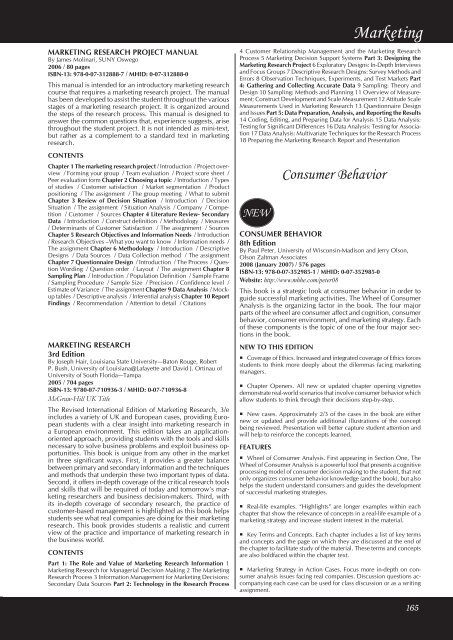Business Communication - McGraw-Hill Books
Business Communication - McGraw-Hill Books
Business Communication - McGraw-Hill Books
Create successful ePaper yourself
Turn your PDF publications into a flip-book with our unique Google optimized e-Paper software.
MARKETING RESEARCH PROJECT MANUALBy James Molinari, SUNY Oswego2006 / 80 pagesISBN-13: 978-0-07-312888-7 / MHID: 0-07-312888-0This manual is intended for an introductory marketing researchcourse that requires a marketing research project. The manualhas been developed to assist the student throughout the variousstages of a marketing research project. It is organized aroundthe steps of the research process. This manual is designed toanswer the common questions that, experience suggests, arisethroughout the student project. It is not intended as mini-text,but rather as a complement to a standard text in marketingresearch.CONTENTSChapter 1 The marketing research project / Introduction / Project overview/ Forming your group / Team evaluation / Project score sheet /Peer evaluation form Chapter 2 Choosing a topic / Introduction / Typesof studies / Customer satisfaction / Market segmentation / Productpositioning / The assignment / The group meeting / What to submitChapter 3 Review of Decision Situation / Introduction / DecisionSituation / The assignment / Situation Analysis / Company / Competition/ Customer / Sources Chapter 4 Literature Review- SecondaryData / Introduction / Construct definition / Methodology / Measures/ Determinants of Customer Satisfaction / The assignment / SourcesChapter 5 Research Objectives and Information Needs / Introduction/ Research Objectives –What you want to know / Information needs /The assignment Chapter 6 Methodology / Introduction / DescriptiveDesigns / Data Sources / Data Collection method / The assignmentChapter 7 Questionnaire Design / Introduction / The Process / QuestionWording / Question order / Layout / The assignment Chapter 8Sampling Plan / Introduction / Population Definition / Sample Frame/ Sampling Procedure / Sample Size / Precision / Confidence level /Estimate of Variance / The assignment Chapter 9 Data Analysis / Mockuptables / Descriptive analysis / Inferential analysis Chapter 10 ReportFindings / Recommendation / Attention to detail / CitationsMARKETING RESEARCH3rd EditionBy Joseph Hair, Louisiana State University—Baton Rouge, RobertP. Bush, University of Louisiana@Lafayette and David J. Ortinau ofUniversity of South Florida—Tampa2005 / 704 pagesISBN-13: 9780-07-710936-3 / MHID: 0-07-710936-8<strong>McGraw</strong>-<strong>Hill</strong> UK TitleThe Revised International Edition of Marketing Research, 3/eincludes a variety of UK and European cases, providing Europeanstudents with a clear insight into marketing research ina European environment. This edition takes an applicationorientedapproach, providing students with the tools and skillsnecessary to solve business problems and exploit business opportunities.This book is unique from any other in the marketin three significant ways. First, it provides a greater balancebetween primary and secondary information and the techniquesand methods that underpin these two important types of data.Second, it offers in-depth coverage of the critical research toolsand skills that will be required of today and tomorrow’s marketingresearchers and business decision-makers. Third, withits in-depth coverage of secondary research, the practice ofcustomer-based management is highlighted as this book helpsstudents see what real companies are doing for their marketingresearch. This book provides students a realistic and currentview of the practice and importance of marketing research inthe business world.CONTENTSPart 1: The Role and Value of Marketing Research Information 1Marketing Research for Managerial Decision Making 2 The MarketingResearch Process 3 Information Management for Marketing Decisions:Secondary Data Sources Part 2: Technology in the Research Process4 Customer Relationship Management and the Marketing ResearchProcess 5 Marketing Decision Support Systems Part 3: Designing theMarketing Research Project 6 Exploratory Designs: In-Depth Interviewsand Focus Groups 7 Descriptive Research Designs: Survey Methods andErrors 8 Observation Techniques, Experiments, and Test Markets Part4: Gathering and Collecting Accurate Data 9 Sampling: Theory andDesign 10 Sampling: Methods and Planning 11 Overview of Measurement:Construct Development and Scale Measurement 12 Attitude ScaleMeasurements Used in Marketing Research 13 Questionnaire Designand Issues Part 5: Data Preparation, Analysis, and Reporting the Results14 Coding, Editing, and Preparing Data for Analysis 15 Data Analysis:Testing for Significant Differences 16 Data Analysis: Testing for Association17 Data Analysis: Multivariate Techniques for the Research Process18 Preparing the Marketing Research Report and PresentationNEWConsumer BehaviorMarketingCONSUMER BEHAVIOR8th EditionBy Paul Peter, University of Wisconsin-Madison and Jerry Olson,Olson Zaltman Associates2008 (January 2007) / 576 pagesISBN-13: 978-0-07-352985-1 / MHID: 0-07-352985-0Website: http://www.mhhe.com/peter08This book is a strategic look at consumer behavior in order toguide successful marketing activities. The Wheel of ConsumerAnalysis is the organizing factor in the book. The four majorparts of the wheel are consumer affect and cognition, consumerbehavior, consumer environment, and marketing strategy. Eachof these components is the topic of one of the four major sectionsin the book.NEW TO THIS EDITION• Coverage of Ethics. Increased and integrated coverage of Ethics forcesstudents to think more deeply about the dilemmas facing marketingmanagers.• Chapter Openers. All new or updated chapter opening vignettesdemonstrate real-world scenarios that involve consumer behavior whichallow students to think through their decisions step-by-step.• New cases. Approximately 2/3 of the cases in the book are eithernew or updated and provide additional illustrations of the conceptbeing reviewed. Presentation will better capture student attention andwill help to reinforce the concepts learned.FEATURES• Wheel of Consumer Analysis. First appearing in Section One, TheWheel of Consumer Analysis is a powerful tool that presents a cognitiveprocessing model of consumer decision making to the student, that notonly organizes consumer behavior knowledge (and the book), but alsohelps the student understand consumers and guides the developmentof successful marketing strategies.• Real-life examples. “Highlights” are longer examples within eachchapter that show the relevance of concepts in a real-life example of amarketing strategy and increase student interest in the material.• Key Terms and Concepts. Each chapter includes a list of key termsand concepts and the page on which they are discussed at the end ofthe chapter to facilitate study of the material. These terms and conceptsare also boldfaced within the chapter text.• Marketing Strategy in Action Cases. Focus more in-depth on consumeranalysis issues facing real companies. Discussion questions accompanyingeach case can be used for class discussion or as a writingassignment.165HED 2007 Marketing.indd 16510/5/2006 1:42:49 PM

















